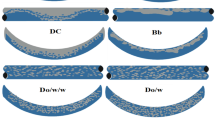Abstract
For drag reduction research an oil channel has been designed and built. It is also well suited for investigations on turbulent flow and in particular on the dynamics of the viscous sublayer near the wall. The thickness of the viscous sublayer (y += 5) can be varied between 1 and 4 mm. Surfaces with longitudinal ribs (“riblets”), which are known to reduce drag, can have fairly large dimensions. The lateral spacing of the ribs can lie between 3 and 10 mm, as compared to about 0.5 mm spacing for conventional wind tunnels. It has been proved by appropriate tests that the oil channel data are completely equivalent to data from other facilities and with other mean flow geometries. However, the shear stress data from the new oil channel are much more accurate than previous data due to a novel differential shear force balance with an accuracy of ±0.2%. In addition to shear stress measurements, velocity fluctuation measurements can be carried out with hot wire or hot film probes. In order to calibrate these probes, a moving sled permits to emulate the flow velocities with the fluid in the channel at rest. A number of additional innovations contribute to the improvement of the measurements, such as, e.g., (i) novel adjustable turbulators to maintain equilibrium turbulence in the channel, (ii) a “bubble trap” to avoid bubbles in the channel at high flow velocities, (iii) a simple method for the precision calibration of manometers, and (iv) the elimination of (Coulomb) friction in ball bearings. This latter fairly general invention is used for the wheels of the calibration unit of the balance. The channel has a cross section of 25 × 85 cm and is 11 m long. It is filled with about 4.5 metric tons of baby oil (white paraffine oil), which is transparent and odorless like water. The kinematic viscosity of the oil is v = 1.2×10−5 m2/s, and the highest (average) velocity is 1.29 m/s. Thus, the Reynolds number range (calculated with the channel width, 0.25 m) lies between 5,000 and 26,800 for fully established turbulent flow.
Similar content being viewed by others
References
Bechert, D. W.; Hoppe, G.; Reif, W.-E. 1985: On the drag reduction of the shark skin. AIAA Paper 85–0546
Bechert, D. W.; Bartenwerfer, M. 1989: The viscous flow on surfaces with longitudinal ribs. J. Fluid Mech. 206, 105–129
Bechert, D. W.; Bartenwerfer, M.; Hoppe, G. 1989/90: Turbulent drag reduction by nonplanar surfaces — a survey on the research at TU/DLR Berlin. Proc. IUTAM Symposium: Structure of turbulence and drag reduction. Zürich 1989. (ed. A. Gyr) Berlin Heidelberg New York: Springer
Eckelmann, H. 1990: Max-Planck-Institut für Strömungsforschung, Göttingen (personal communication)
McLean, J.D.; George-Falvy, D. N.; Sullivan, P. P. 1987: Flight-test of turbulent skin-friction reduction by riblets. Proc. Turbulent drag reduction by passive means, Royal Aeronautical Society, London, 15–17 Sept. 1987
Nitschke, P. 1983: Experimentelle Untersuchung der turbulenten Strömung in glatten und längsgerillten Rohren. Max-Planck-Institut für Strömungsforschung. Bericht 3/1983
Sawyer, W. G.; Winter, K. G. 1987: An investigation of the effect on turbulent skin friction of surfaces with stream wise grooves. Proc. Turbulent drag reduction by passive means, Royal Aeronautical Society, London 15–17 Sept. 1987
Walsh, M. J. 1980: Drag characteristics of V-groove and transverse curvature riblets. In: Viscous flow drag reduction (Ed. G. R. Hough), Progress in Astronautics and Aeronautics, Vol. 72, AIAA, New York
Walsh, M. J. 1982: Turbulent boundary layer drag reduction using riblets. AIAA Paper 82-0169
Walsh, M. J.; Lindemann, A. M. 1984: Optimization and application of riblets for turbulent drag reduction. AIAA Paper 84-0377
Walsh, M. J.; Sellers III, W. L.; McGinley, C. B. 1989: Riblet drag at flight conditions. J. Aircraft 26, 570–575
Author information
Authors and Affiliations
Rights and permissions
About this article
Cite this article
Bechert, D.W., Hoppe, G., van der Hoeven, J.G.T. et al. The Berlin oil channel for drag reduction research. Experiments in Fluids 12, 251–260 (1992). https://doi.org/10.1007/BF00187303
Received:
Issue Date:
DOI: https://doi.org/10.1007/BF00187303



